The Google Nexus 9 Review
by Joshua Ho & Ryan Smith on February 4, 2015 8:00 AM EST- Posted in
- Tablets
- HTC
- Project Denver
- Android
- Mobile
- NVIDIA
- Nexus 9
- Lollipop
- Android 5.0
GPU Performance
While Denver is new, the Kepler GPU in the Tegra K1 is mostly a known quantity by now. In the Nexus 9, the GPU is still a single SMX clocked to 852 MHz. In order to verify performance, we turn to our standard test suite. For the most part, our GPU-bound tests are meant to represent gaming performance although tests like 3DMark can have CPU-bound aspects while GFXBench tends towards being a pure GPU test.
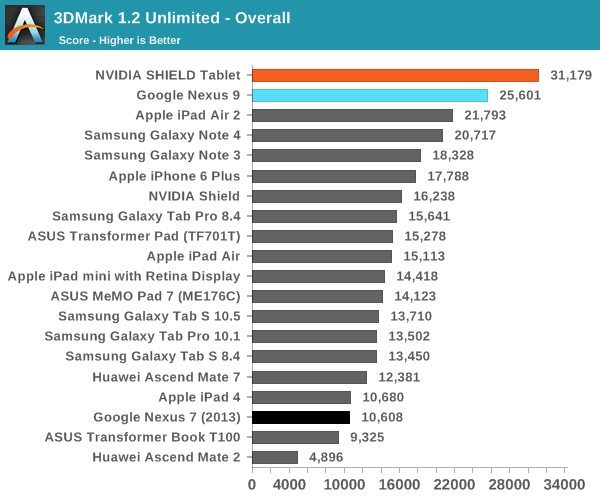
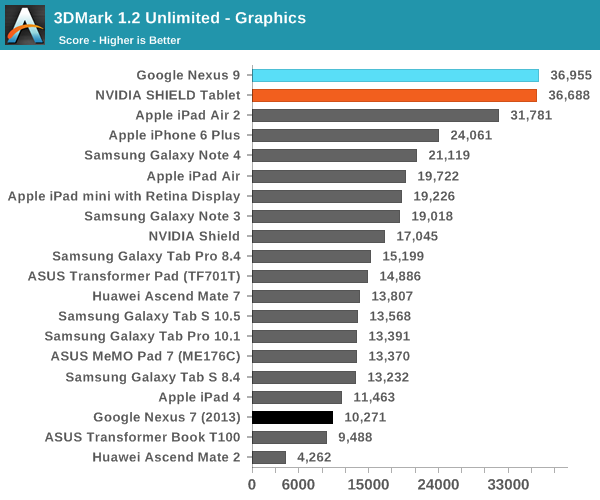
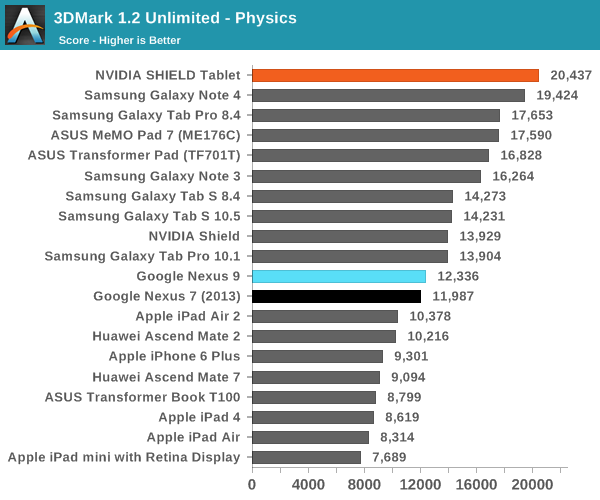
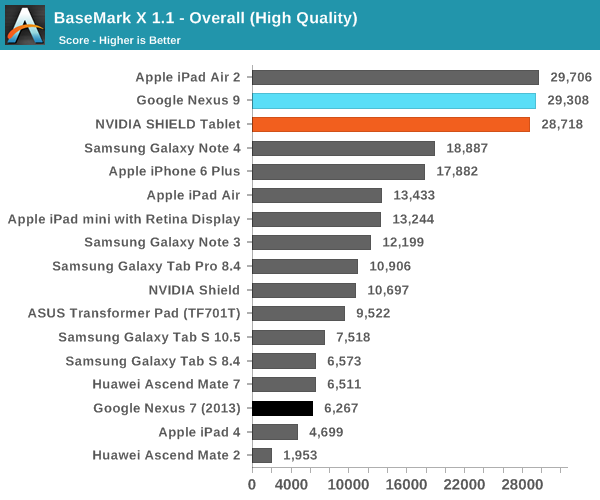
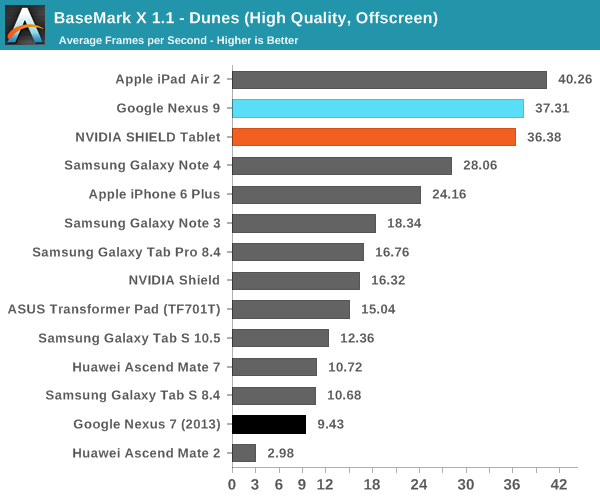
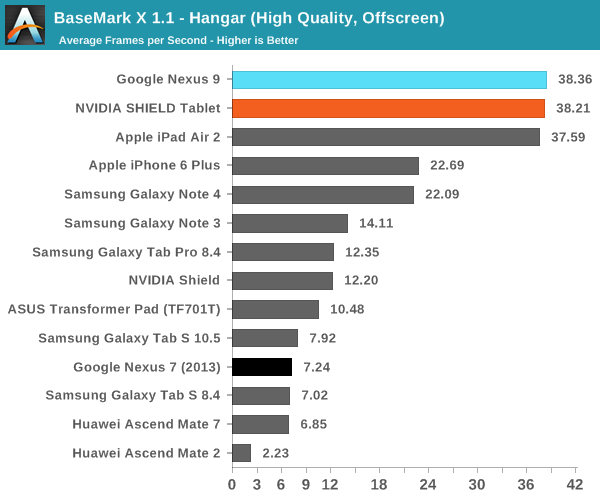
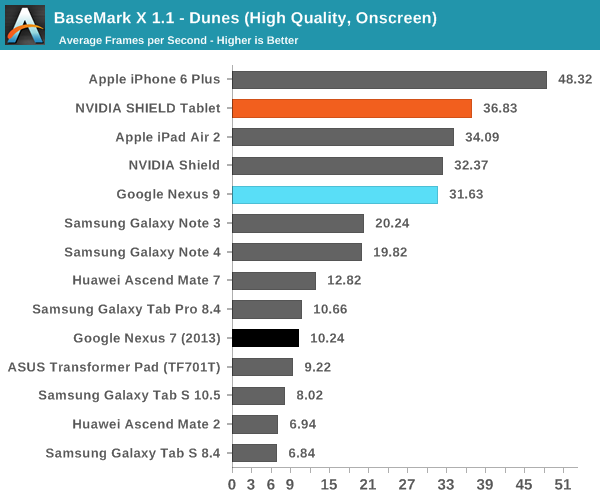
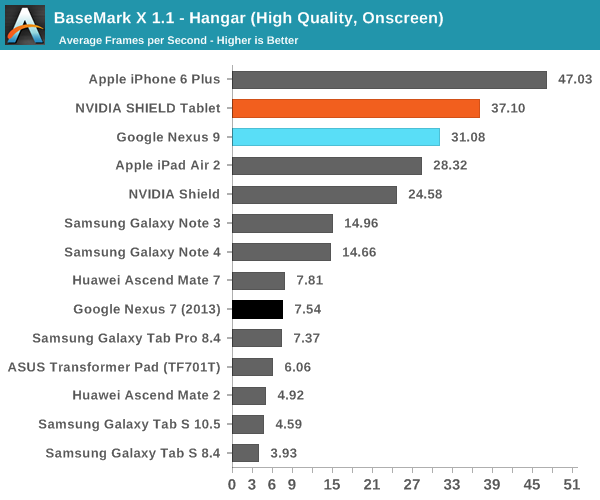
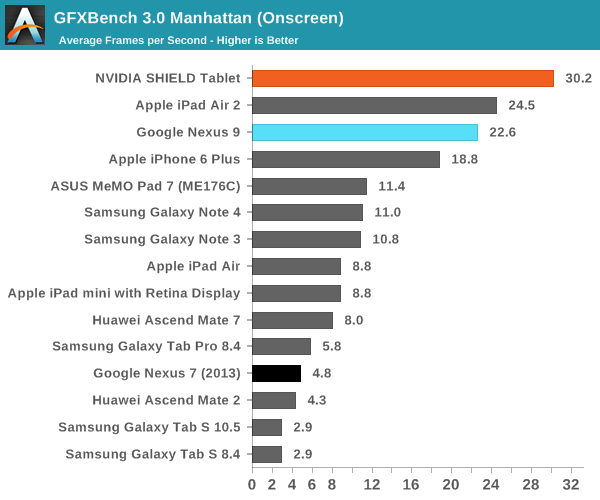
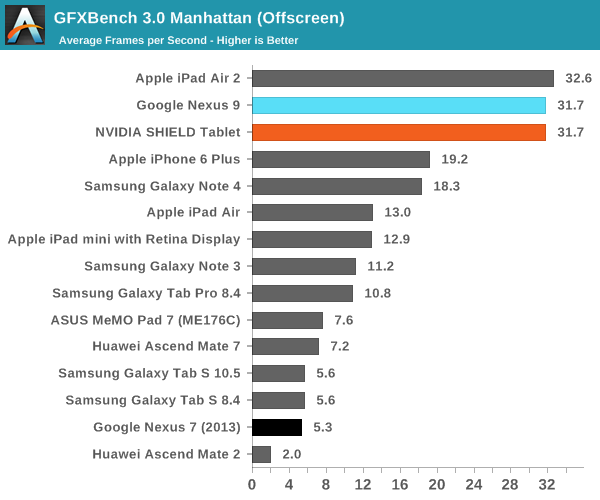
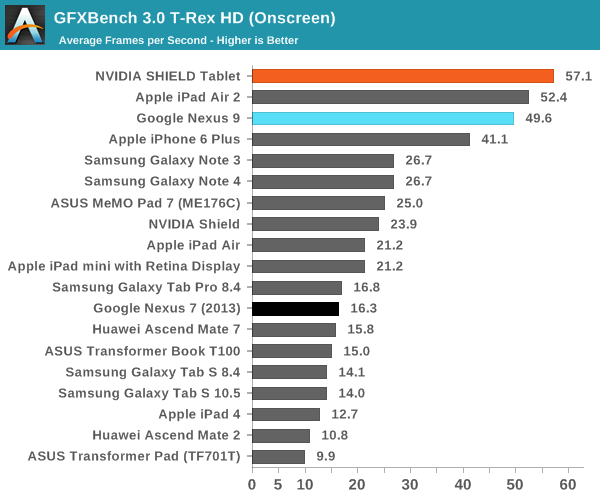
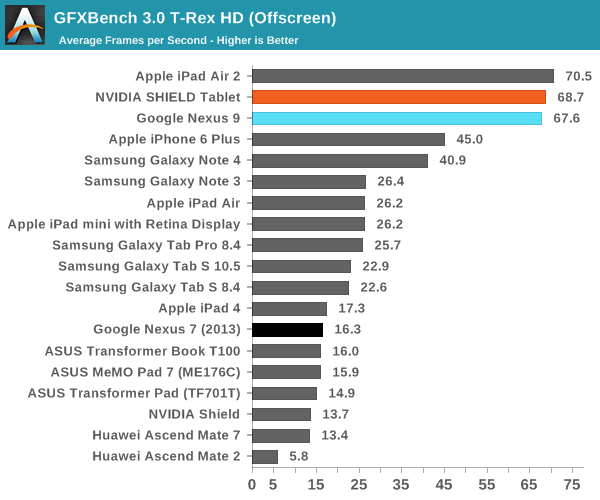
The Nexus 9's GPU has effectively identical performance to what we saw in the SHIELD Tablet, which means that the Nexus 9 should be able to support a broad range of games without performance issues. There is a bit of a noticeable performance delta when comparing on-screen performance, but this is simply due to the higher resolution of the Nexus 9's display. The one notable exception is the 3DMark physics test, which seems to scale with core count quite well, and that causes Denver to fall slightly short of the quad A15 configuration.
NAND Performance
While storage performance can often be secondary to a smooth user experience, poor storage performance is extremely painful. This is similar to RAM, where the difference between 2 and 3 GB is generally academic, while the difference between 512MB and 1 GB is enormous. While there have been some issues with Androbench with the move to Android 5.0, it seems that the timer issues have since been resolved, so it's possible to resume using the results from Androbench to get a rough idea of NAND performance.
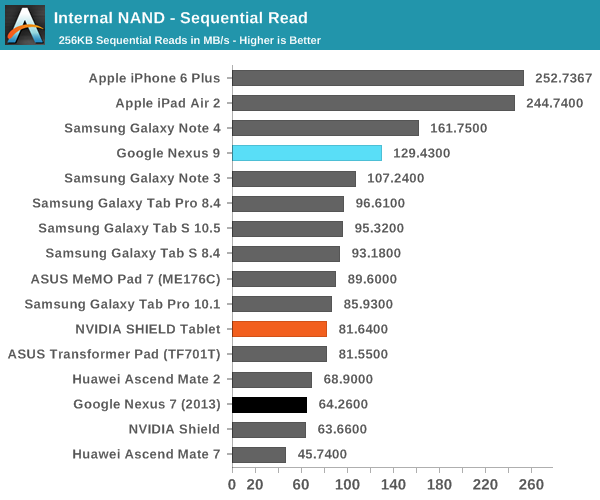
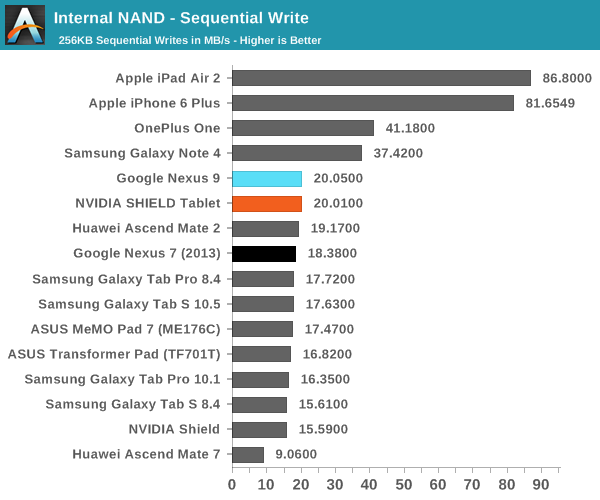
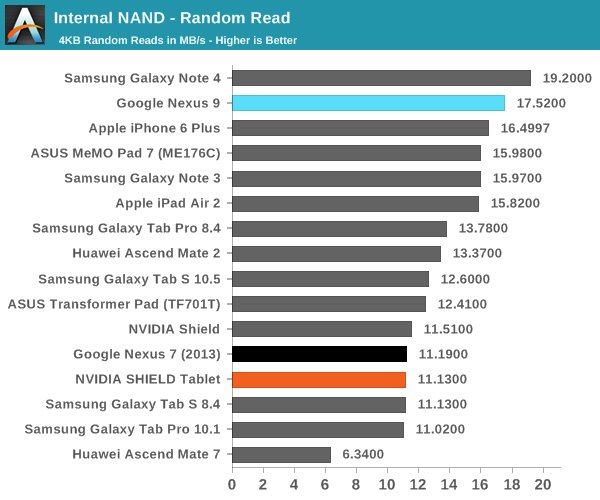
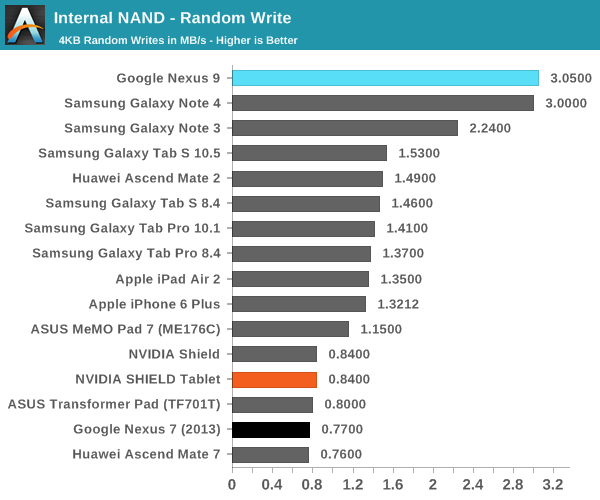
Here the Nexus 9 doesn't suffer nearly as much from full disk encryption that is forcibly enabled on the device; performance is noticeably higher than what we see in the Nexus 6. This seems to lend some credence to the theory that CPUs with ARM v8 ISA would be better suited to handling the need to encrypt and decrypt storage in real time. I tested the Nexus 9 with a custom kernel without full disk encryption to see how Androbench scores might change, but this didn't have a noticeable impact which seems to back this theory, although I'm still not confident that FDE is a good idea to enforce across all new devices.
The NAND itself, a Samsung eMMC package designated by the name BWBC3R, seems to be quite performant outside of pure sequential access, which seems to suggest that HTC hasn't skimped out in this area at all, and the use of F2FS is responsible for some of the best random I/O scores in any mobile devices we've tested thus far.










169 Comments
View All Comments
seanleeforever - Wednesday, February 4, 2015 - link
2nd that.I am not here to read about how fast the tablet is or how nice it looks. i am here for in depth content about the chip. would it be nice that this content was available since the release of the product? absolutely, but given the resource it would either be a brief review that is going to be the same as review you can find from hundred of other websites, or late but in depth.
honestly i think anand should be targeting at more tech oriented contents that's few but in depth, and leave the quick/dirty review for other websites.
superb job.
WaitingForNehalem - Wednesday, February 4, 2015 - link
Yeah but who cares about tablets??!! I don't come to Anandtech to read about budget tablets, or SFF PCs, or more smartphones. The Denver coverage was not even that in depth TBH, just commentary on the NVidia slides. I have a EE degree and some of the previous write ups were so in depth they could be class material. This one isn't which is fine but I don't think it excuses how late it came out. The enthusiast market is growing and you should be targeting that demographic as you previously have, not catering to the mainstream like hundreds of sites already do.retrospooty - Wednesday, February 4, 2015 - link
The enthusiast market is growing ? What with CPU's not really getting, or needing to be any faster for several years now, and a standard mid range quad core i5 (non-overclocked) being WAY more than powerful enough to run 99.9% of anything out there, how is the enthusiast market is growing? Most enthusiasts I know don't even bother any more... There just isnt a need. Any basic PC is great these days.WaitingForNehalem - Wednesday, February 4, 2015 - link
I totally agree with you. That doesn't change the fact that the market is growing as more users are adopting gaming PCs. Enthusiasts now actually command a sizable portion of desktops sold. Intel's Devil's Canyon was in response to that.retrospooty - Thursday, February 5, 2015 - link
OK, I get what you mean.I guess I am still in a mind set where a PC "enthusiast" is your overclocker, tweaker, buying the latest and fastest of everything to eek out that extra few frames per second.
Today, a mid range quad core i5 from 3 years ago and a decent mid-high range card runs any game quite nicely.
FunBunny2 - Thursday, February 5, 2015 - link
There was a time, readers may be too young to have been there, when there was a Wintel monopoly: M$ needed faster chips to run ever more bloated Windoze and Intel needed a cycle-sink to soak up the increase in cycles that evolving chips provided. Now, we're near (or at?) the limits of single-threaded performance, and still haven't found a way to use multi-processor/core chips in individual applications. There just aren't a) many embarrassingly parallel problems and b) algorithms to turn single-threaded problems into parallel code. I mean, the big deal these days is 4K displays? It looks prettier, to some eyes, but doesn't change the functionality of an application (medical and such excepted, possibly).Does anyone really need an i7 to surf the innterTubes for neater porn?
nico_mach - Friday, February 6, 2015 - link
I think the chip coverage was superb, I don't have an EE degree and I'm pretty sure that's what the website is steered towards. And I still think I got it.It's fascinating the number of layers involved in this Android tablet, and speaks to why Apple can optimize so much better. There's the chip->NVIDIA chip optimizer->executable code->Dalvik compiler/runtime->dalvik code. I mean, when the lags are encountered, that's twice as many suspects to investigate.
I still think that the review is a little harsh on Denver. It's hitting the right performance envelope at the right price. While it's an mildly inefficient design, clearly NVIDIA is pricing it accordingly, and that might be a function of moving some of the optimization work to software. And that's work that Apple and MS do all the time - Apple much more successfully, obviously. There's a real gap in knowledge of how efficient Apple's chips are vs how optimized the software/hardware pairing is.
dakishimesan - Wednesday, February 4, 2015 - link
I have no interest in tablets, but the deep dive on Denver was a fascinating read, and still completely relevant even if the product is a few months old. Thanks for the great review.Sindarin - Wednesday, February 4, 2015 - link
...can I offer you a cup of hot chicken soup laddy? .....maybe some vicks vapor rub? lol! c'mon dude! we're all sick(vaca) in December!hahmed330 - Wednesday, February 4, 2015 - link
Hi, outstanding article with incredible attention to detail... Do you think its possible to run Dynamic Code Optimizer on per say 2 or maybe even 4 small cpu cores dedicated to doing all the software OoOE functions instead of using time slicing? (A53s or just some XYZ narrow cores for a potential 2+2 or 4+4 or maybe even 8+8)Also whats the die size of a denver core in comparison to a enhanced cyclone core?? That is where a lot of gains are possible potentially 30%-50%..